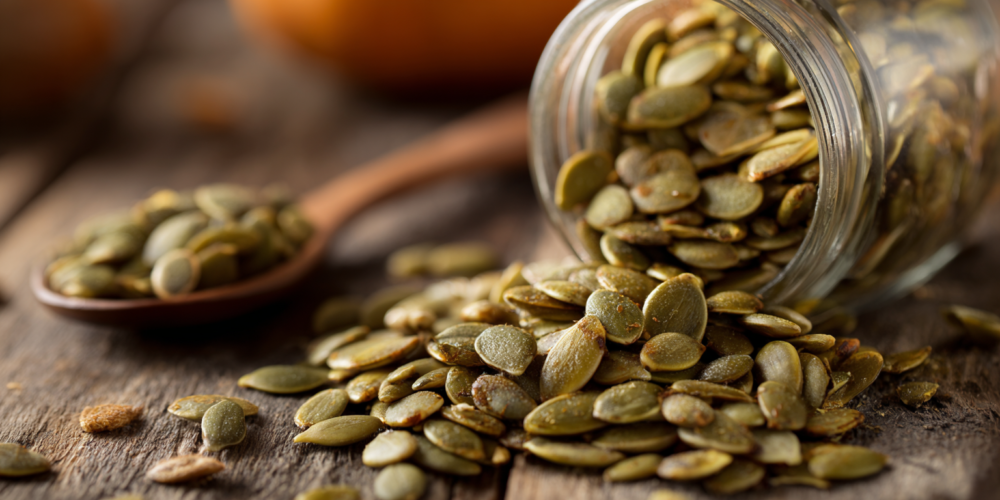2. Flax Seeds: The Fiber and Lignan Powerhouse

Flax seeds, originating in Mesopotamia, were cultivated by the Babylonians not only for their fiber (used for linen) but also as a significant food source. Cultures from ancient Egypt to Europe and the Vikings all revered flax. Today, flax seeds have made a huge comeback, appreciated for their health benefits.
Key Takeaways for Flax Seeds:
- Fiber Source: Provide both soluble and insoluble fiber, aiding digestion and regularity.
- Omega-3 Content: A good source of plant-based omega-3s (ALA), though conversion to EPA/DHA is inefficient.
- Lignans: Contain lignans, potent compounds with anti-cancer and nerve-regenerating properties, in very high amounts.
- Vitamins and Minerals: Offer thiamine (B1) and minerals like magnesium, copper, and phosphorus.
Flax seeds are typically brown or yellow, with brown seeds generally offering more nutritional benefits. They are a great source of omega-3 fatty acids and dietary fiber. It’s recommended to buy them whole and grind them yourself in small batches, then refrigerate the unused portion, as ground flax seeds can oxidize quickly, losing their health benefits. Whole flax seeds provide both soluble and insoluble fiber. Soluble fiber helps regulate blood sugar and cholesterol, feeds beneficial gut bacteria, and contributes to digestive health. The combination of fibers makes flax seeds a natural laxative, promoting regular bowel movements.
While flax seeds contain many essential amino acids, they aren’t considered a complete protein because they lack the amino acid lysine. Therefore, they aren’t the primary choice for protein needs, with hemp seeds being a better option. Flax seeds are second only to chia seeds in terms of plant-based omega-3s. However, it’s important to remember that plant-based omega-3s (ALA) need to be converted by the body into EPA and DHA, a process that is quite inefficient. Studies suggest only about 8-21% of ALA converts to EPA, and even less to DHA. Since EPA and DHA are critical for brain and nerve health, consuming fish or fish oil is a more direct way to get these beneficial fats.
Flax seed oil carries many of the same benefits but should never be heated, as heat destroys its health properties. Flax seeds are a good source of thiamine (B1), which is essential for metabolism and nerve function, and manganese, a trace mineral important for brain and nerve cells that can help prevent nerve cell degeneration. They also contain magnesium, copper, and phosphorus. The most notable compound in flax seeds is lignan, which is found in much higher concentrations than in other foods (up to 800 times more). Lignans have been shown to play a vital role in nerve regeneration after injury, assist in cancer and heart disease prevention, and help maintain bone strength.
1. Pumpkin Seeds: The Underappreciated Nutrient Powerhouse

Pumpkin seeds, also known as pepitas, are the seeds found inside pumpkins. They are cleaned, roasted, or dried. Raw pumpkin seeds generally offer a stronger nutritional profile than roasted ones.
Key Takeaways for Pumpkin Seeds:
- Good Protein Source: Provide a decent amount of protein, though not a complete protein.
- Omega-3s: Contain plant-based omega-3 fatty acids (ALA).
- Rich in Vitamins & Minerals: Loaded with manganese, copper, magnesium, phosphorus, potassium, sodium, iron, zinc, and various B vitamins, plus vitamins C, K, and E.
- Antioxidant Rich: Contain phenolic acids and flavonoids, which are anti-inflammatory, anti-cancer, antiviral, and neuroprotective.
- Potential Cancer Benefits: Studies suggest lignans in pumpkin seeds may help prevent and treat breast cancer.
- Prostate Health: May help reduce symptoms associated with an enlarged prostate (BPH).
Two ounces of pumpkin seeds contain 5 grams of protein. While they contain all nine essential amino acids, they are not considered a complete protein due to low levels of methionine and tryptophan. Like the other seeds, pumpkin seeds are rich in omega-3 fatty acids in the form of ALA. They are also packed with a wide range of vitamins and minerals, including manganese, copper, magnesium, phosphorus, potassium, sodium, iron, zinc, and various B vitamins, as well as vitamins C, K, and E.
These humble seeds are also rich in antioxidants like phenolic acids and flavonoids. Flavonoids, in particular, have anti-inflammatory, anti-cancer, antiviral, and neuroprotective properties, meaning they can shield your nerves from damage. Research from 2002 indicated that eating pumpkin seeds was linked to a reduced risk of breast cancer in post-menopausal women, and other studies suggest lignans in pumpkin seeds may play a role in preventing and treating breast cancer. Additionally, several studies have found that consuming pumpkin seeds can help reduce symptoms associated with benign prostatic hyperplasia (BPH), an enlarged prostate that can cause urinary problems.
Embracing the Seeds of Change
As we conclude this exploration of chia, hemp, flax, and pumpkin seeds, it’s clear they offer a symphony of nutrients and healing potential. Whether you’re enjoying chia pudding, sprinkling hemp seeds on a salad, adding ground flax to a smoothie, or crunching on pumpkin seeds, you’re embracing a legacy of nourishment that spans centuries and cultures. These tiny seeds hold mighty impact, contributing to better nerve health and overall well-being. So, remember to incorporate these powerhouses into your diet for a richer, more vibrant future.
Source: Dr. Valarie Monteiro

